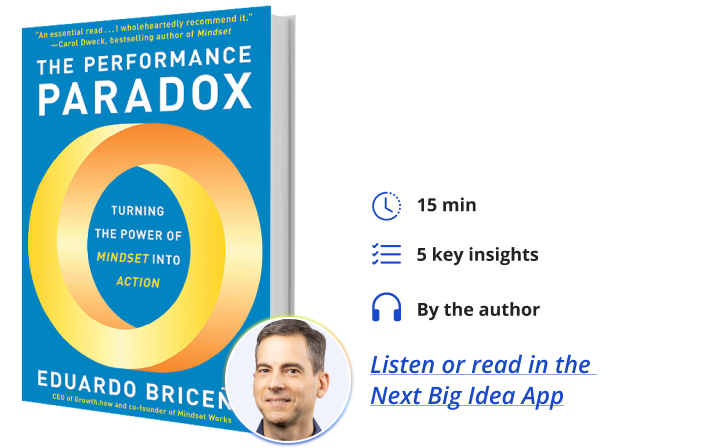Eduardo Briceño is a global keynote speaker, facilitator, and program provider who supports organizations in developing cultures of learning and high performance. He was the co-founder and CEO of Mindset Works, the first company to offer growth mindset development services. Previously, he was a venture capital investor with the Sprout Group. His TED Talks have been viewed more than nine million times. He is a Pahara-Aspen Fellow, a member of the Aspen Institute’s Global Leadership Network, and an inductee in the Happiness Hall of Fame.
Below, Eduardo shares five key insights from his new book, The Performance Paradox: Turning the Power of Mindset into Action. Listen to the audio version—read by Eduardo himself—in the Next Big Idea App.

1. If we focus only on performing, our performance suffers.
This is what is referred to as the performance paradox. It is what most of us are doing almost all of the time—we’re focused on performing. To understand this paradox, it helps us to step out of our everyday context and examine how the greatest performers in the world, in domains where performance can be objectively measured, come to get so good at what they do.
We might think that they get so good because they spend a lot of time doing those activities, and that’s what leads to improvement, but that’s not the case. For example, among serious chess players, the ones who spend the most time playing games and tournaments are not the ones who achieve the highest skill and ranking.
Consider how much time most of us spend typing on the computer keyboard without becoming world-class. Most of us haven’t gotten better in the last few years, even though we’ve put in a lot of hours typing. Research also shows that the more years of experience that medical doctors have seeing patients and doing their job, on average, the lower their patient outcomes. Of course, some get better over time. Those are the ones who understand the performance paradox and understand how to overcome it.
2. We can overcome the performance paradox.
To do that, we have to make the Learning Zone a part of our work and lives. What does that mean? Think of a world-class athlete, like a professional tennis player. If she’s playing a high-stakes match in a tournament and having trouble with a particular move, she’s going to avoid that move during the match, because she’s doing whatever is most likely to lead her to win the game. After the match, though, she’ll go to her coach and say, “I have to work on my top-spin serve,” and that’s a very different activity. She’s in a different area of focus and attention than she would be during the match. When she’s focused on improvement, she is in the Learning Zone. The Learning Zone allows her to develop world-class skills and perform expertly during the match, which is called the Performance Zone.
Most of us are stuck in chronic performance. In our Performance Zones, we are constantly working hard, as best as we know how, trying to minimize mistakes, but that is what keeps us stagnant. People in sports and the performance arts have the privilege of being able to devote large blocks of time to their Learning Zone where they fully focus on improvement. But most of us are in a different situation: we have a very long to-do list, with little time, and we might not be set up to devote large blocks of time to invest in improving our skills. For most of us, the greatest opportunity is to incorporate the Learning Zone into the Performance Zone. That means that we shift the way we do things. By combining these two zones, we start to do things with not just the goal to get things done, but with two goals in mind. The goals are to perform and improve. It doesn’t have to take more time, it’s more about how we work.
“Most of us are stuck in chronic performance.”
We don’t learn by doing. The pioneers of experiential learning understood this. We can learn while doing, and to do that we have to shift how we work and live. We have to regularly change or tweak the way we do things. We need to develop hypotheses, ask questions, learn from experts, gather ideas, experiment, reflect on and share mistakes, and solicit feedback. Those are things that don’t take much time but have huge returns, leading to greater results in less time.
3. Mistakes are not universally good or bad.
We need to develop a more nuanced understanding of mistakes. Most of us know we can learn from mistakes, but we don’t realize how central and necessary they are. It turns out that from our mid-20s on, mistakes are the main way that we can elicit our own neuroplasticity. Neuroplasticity is the changing of our brain, it’s how we become smarter and more capable. The way the brain changes is by making a prediction and realizing that that prediction was wrong. That’s how critical mistakes are.
But, that’s not the whole story. The flip side is that mistakes also lower our performance; great performances involve few or indiscernible mistakes. So, what do we do?
We can develop a more nuanced understanding of mistakes by unpacking four kinds of mistakes. The first are stretch mistakes, which are mistakes we make when we’re trying something we have not yet mastered. They’re the mistakes we make in our Learning Zone and we need to make a lot of them. We don’t do this by trying to do things incorrectly, but by trying to do things that are challenging, and beyond what we can do. We want to do these things at times and spaces where they’re not likely to create significant damage.
The second kind of mistake is the high-stakes mistake, which creates significant damage. These are mistakes we want to try to avoid. When the consequences of a mistake would be significant, we want to shift to our Performance Zone and try our best to do what we know works, and minimize mistakes. Whether that’s driving a school bus, performing surgery, or packing a parachute, we want to do our best to minimize mistakes with high stakes.
“We can develop a more nuanced understanding of mistakes by unpacking four kinds of mistakes.”
Third are the sloppy mistakes, which happen when we do things incorrectly that we already know how to do. Sometimes these sloppy mistakes are small, and not important. If I’m home and I spill my smoothie all over my shirt, I have a choice, I can get upset or I can laugh. I often choose to laugh, and I often share a picture with my friends and family so they can laugh too. Mistakes can add life and joy to our lives. But sometimes sloppy mistakes do create damage, so if that’s the case, we want to reflect on what we can learn and what we can do differently. When we do this, sloppy mistakes often reveal an opportunity to foster greater focus or to make changes to our systems or tools to prevent the mistake from repeating. If I don’t want to spill the smoothie on myself anymore, I could change where I put the glass on my desk.
Finally, there’s the a-ha moment mistake, which is when we do something as we intended, but then realize it was the wrong to do. If my spouse is upset and I ask her what’s going on and try to problem solve with her, I might learn that what she needed was not for me to problem solve, but to be there with her and to empathize. We can’t proactively elicit a-ha moment mistakes, like we can stretch mistakes. When a-ha moment mistakes happen, we need to treasure them because they are precious. We need to reflect on them and extract their gifts.
Those are the four kinds of mistakes—but beware of weaponizing them. What you see as a sloppy mistake, somebody else might see as a stretch mistake or as an a-ha moment mistake. We need to approach mistakes with a spirit of curiosity and collaboration because if others feel they’ll be punished if they make a mistake, they’ll revert to a chronic Performance Zone.
4. Being an effective learner and performer is about developing cultures and relationships where learning is valued and the everyday default.
Being an effective learner doesn’t involve just a growth mindset and knowing how to grow. It’s also not just about each of us developing certain beliefs and habits. Sometimes teachers or leaders feel that students or staff just need a growth mindset, but a growth mindset, and the habits for how to improve, are largely influenced by the people around us. We develop and engage in these things in partnership with others. We must foster cultures and systems that make learning-while-doing the easy default and the way things are done.
“We understand that hiccups, mistakes, and failures are just part of the process.”
For example, the top hundred leaders at LinkedIn have a weekly meeting, where a section of that meeting is devoted to inviting anyone to share something they learned the prior week. That way, they spread the lessons and they strengthen their learning culture. At Netflix, when people make mistakes, they’re encouraged to share them. At Clear Choice Dental Implants, they use videos of interactions with patients, when patients consent to it, to examine opportunities for improvement. The video can only be used for development purposes, and only viewed by the person in the video. The videos are not for evaluation, because when people are being evaluated, they shift to their performance zone, with good reason.
5. Incorporating the Learning Zone into our work and lives changes not only the destination but also the journey.
When the Learning Zone is part of our everyday lives, we not only attain greater performance, achievement, and impact but we also experience lower anxiety and symptoms of depression. We understand that hiccups, mistakes, and failures are just part of the process. They are temporary and great opportunities for learning. We understand that feedback is something anyone can benefit from and that the most competent people in the world use feedback all the time to get better.
The Learning Zone also leads us to develop deeper and more collaborative relationships with those around us. This is in part because of how we come to view feedback, but also because we become more curious about learning about others’ experiences and situations. We ask more questions and listen better. We give others a chance to share more of themselves so we get to know them better, and they get to know us better. With greater trust and understanding, not only do we have better relationships, but also we can learn and perform better. Life also becomes richer, more joyful, and more fulfilling because we’re exploring more. We are experiencing discovery and awe, which makes life more interesting and engaging.
This work is about changing not only the destination but also the journey. At the end of the day, our human world is a collection of what we all do. So, stay in the Learning Zone.
To listen to the audio version read by author Eduardo Briceño, download the Next Big Idea App today:































